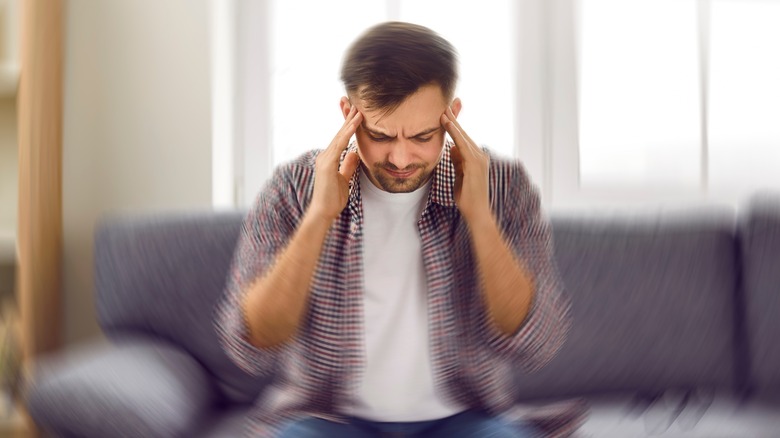What It Means When You Feel Dizzy After Lying Down
Most kids, when they're young, enjoy reaching their arms wide and spinning around until they're dizzy. They might walk clumsily until they find equilibrium again, or they'll collapse on the floor until steadiness returns. When dizziness isn't intentional (such as when getting up too fast or feeling lightheaded from dehydration or a cold), it can be scary.
For the most part, you can find some relief from dizziness by sitting or lying down. But what happens when you get dizzy after you lie down? If you experience dizziness or vertigo in bed, this could cause you to fall off your bed. The most common cause of dizziness after lying down is benign paroxysmal positional vertigo (BPPV), which is an episode of dizziness that only lasts for 10 to 20 seconds (via the National Dizzy and Balance Center). It's mostly caused by a change in your head position, such as when you roll over on your bed or when you move from sitting to lying down (via Johns Hopkins Medicine).
How dizziness occurs with BPPV
We all have calcium crystals in our inner ear that help us get a sense of gravity and balance. Sometimes these crystals will detach from the inner ear and move to the semicircular canal in our ear. These three semicircular canals detect our head movements. When enough of these crystals move into one of these canals, they hamper our ability to detect our head movements. This triggers a nerve that signals to the brain that the head is moving when it isn't. This causes some confusion, especially when the other ear and your muscles and joints don't sense this movement. That's what causes vertigo, or the feeling that everything around you is spinning (via Vestibular Disorders Association).
Although the most common symptom of BPPV is vertigo, you could also feel nausea, vomiting, or a loss of balance. This could make people believe they're having a stroke, according to Johns Hopkins Medicine. Although the cause of BPPV isn't known, mild head trauma, riding your bike in rough terrain, high-intensity aerobics, or an inner ear infection could put you at greater risk. Having your head in the same position for a long time, such as sitting in a dentist's chair or being bedridden, could also put you at risk for BPPV.
How BPPV is diagnosed and treated
Because an MRI can't show the movement of the crystals into the semicircular canal, a doctor or vestibular rehabilitation therapist can diagnose BPPV using the Dix-Hallpike maneuver. The medical professional will move your head so that the calcium crystals will move and trigger your vertigo. A sign of BPPV is nystagmus, which is an involuntary, repetitive movement of the eyes (via Vestibular Disorders Association).
BPPV is commonly treated using the Epley maneuver. This involves a series of head movements done while lying down, which helps guide the loose crystals out of the semicircular canal back into the place in your inner ear where they belong. Some people might find relief after the first treatment, but others might need additional treatment. After treatment, you might need to avoid moving your head too far back or bending too far forward. If you sleep on the affected ear, you might need to sleep on the opposite side (via Johns Hopkins Medicine).
BPPV only involves sudden, brief episodes of dizziness. If you're experiencing constant dizziness, it could indicate another condition, particularly if it's accompanied by other neurological symptoms such as lack of coordination, trouble speaking, or numbness (via Vestibular Disorders Association).



